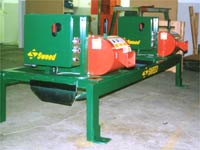|
Coil Slitting Operations Materials processed in the strip metal processing industry: Steel strapping-Models 400, 450, and larger. Slitter edge trim-Models vary per capacity and material thickness. Contact us for specific Engineering consultation for chopper selection. Running a metal slitting operation requires speed and safety. The common method is to wind slitter edge trim onto a reel. When the reel is full, the line is stopped and the reel is emptied. This consumes time as well as placing your employees at risk of injury. Some edge trim coils can weigh hundreds of pounds. The edge trim now needs to be rethreaded back onto an empty spool, increasing worker contact with a dangerous situation. With a slitter line edge chopper, the master coil is only threaded once. The edge trim is directly fed into a chopper on both sides of the coil. This minimizes worker contact and will also raise the price of your edge scrap. The choppers are set up to correspond with the speed of the slitting operation. The chopped material ends up in a scrap container on its own, never placing workers at risk for cutting themselves or throwing their backs out. This translates into big savings for company owners that would rather not throw money at worker injury claims. The steel banding that is associated with coils is also better off if it is chopped, rather than sitting on the floor waiting to injure someone or half filling a scrap hopper.
A Sweed slitter trim chopper for a new line. Retrofit would look slightly different.
|
